In Vitro and In Vivo Phenotypes of Venezuelan, Eastern and Western Equine Encephalitis Viruses Derived from cDNA Clones of Human Isolates
Abstract
1. Author Summary
2. Introduction
3. Materials and Methods
3.1. Ethics Statement
3.2. Cell Culture
3.3. cDNA Clone Sequences
3.4. cDNA Clone Construction and Virus Generation
3.5. Mouse Infections
3.6. Plaque Size Determination
3.7. Relative Infectivity Assay
3.8. Expression of Infection Reporter Proteins
3.9. Statistical Analysis
4. Results
4.1. Comparison of Biological Isolate Sequences with Type-Specific Sequences
4.2. In Vitro Phenotype Comparison of Viruses Derived from cDNA Clones
4.3. In Vivo Phenotype Comparison of Viruses Derived from cDNA Clones
4.4. Comparisons of Reporter Expressing Viruses
5. Discussion
Author Contributions
Funding
Institutional Review Board Statement
Informed Consent Statement
Data Availability Statement
Conflicts of Interest
References
- Griffin, D. Alphaviruses. In Fields Virology, 6th ed.; Knipe, D., Howley, P., Eds.; Lippincott Wiliams & Wilkins: Philadelphia, PA, USA, 2013. [Google Scholar]
- Weaver, S.C.; Ferro, C.; Barrera, R.; Boshell, J.; Navarro, J.C. Venezuelan equine encephalitis. Annu. Rev. Entomol. 2004, 49, 141–174. [Google Scholar] [CrossRef] [PubMed]
- Vittor, A.Y.; Armien, B.; Gonzalez, P.; Carrera, J.P.; Dominguez, C.; Valderrama, A.; Glass, G.E.; Beltran, D.; Cisneros, J.; Wang, E.; et al. Epidemiology of Emergent Madariaga Encephalitis in a Region with Endemic Venezuelan Equine Encephalitis: Initial Host Studies and Human Cross-Sectional Study in Darien, Panama. PLoS Negl. Trop. Dis. 2016, 10, e0004554. [Google Scholar] [CrossRef] [PubMed]
- Zacks, M.A.; Paessler, S. Encephalitic alphaviruses. Vet. Microbiol. 2010, 140, 281–286. [Google Scholar] [CrossRef] [PubMed]
- Forrester, N.L.; Kenney, J.L.; Deardorff, E.; Wang, E.; Weaver, S.C. Western Equine Encephalitis submergence: Lack of evidence for a decline in virus virulence. Virology 2008, 380, 170–172. [Google Scholar] [CrossRef] [PubMed]
- Hanson, R.P.; Sulkin, S.E.; Beuscher, E.L.; Hammon, W.M.; McKinney, R.W.; Work, T.H. Arbovirus infections of laboratory workers. Extent of problem emphasizes the need for more effective measures to reduce hazards. Science 1967, 158, 1283–1286. [Google Scholar] [CrossRef] [PubMed]
- Bowen, G.S.; Fashinell, T.R.; Dean, P.B.; Gregg, M.B. Clinical aspects of human Venezuelan equine encephalitis in Texas. Bull. Pan Am. Health Organ. 1976, 10, 46–57. [Google Scholar] [PubMed]
- Steele, K.E.; Twenhafel, N.A. Review Paper: Pathology of animal models of alphavirus encephalitis. Vet. Pathol. 2010, 47, 790–805. [Google Scholar] [CrossRef]
- Rusnak, J.M.; Glass, P.J.; Weaver, S.C.; Sabourin, C.L.; Glenn, A.M.; Klimstra, W.; Badorrek, C.S.; Nasar, F.; Ward, L.A. Approach to Strain Selection and the Propagation of Viral Stocks for Venezuelan Equine Encephalitis Virus Vaccine Efficacy Testing under the Animal Rule. Viruses 2019, 11, 807. [Google Scholar] [CrossRef]
- Davis, N.L.; Powell, N.; Greenwald, G.F.; Willis, L.V.; Johnson, B.J.; Smith, J.F.; Johnston, R.E. Attenuating mutations in the E2 glycoprotein gene of Venezuelan equine encephalitis virus: Construction of single and multiple mutants in a full-length cDNA clone. Virology 1991, 183, 20–31. [Google Scholar] [CrossRef]
- Ludwig, G.V.; Turell, M.J.; Vogel, P.; Kondig, J.P.; Kell, W.K.; Smith, J.F.; Pratt, W.D. Comparative neurovirulence of attenuated and non-attenuated strains of Venezuelan equine encephalitis virus in mice. Am. J. Trop. Med. Hyg. 2001, 64, 49–55. [Google Scholar] [CrossRef]
- Jackson, A.C.; SenGupta, S.K.; Smith, J.F. Pathogenesis of Venezuelan equine encephalitis virus infection in mice and hamsters. Vet. Pathol. 1991, 28, 410–418. [Google Scholar] [CrossRef] [PubMed]
- Charles, P.C.; Trgovcich, J.; Davis, N.L.; Johnston, R.E. Immunopathogenesis and immune modulation of Venezuelan equine encephalitis virus-induced disease in the mouse. Virology 2001, 284, 190–202. [Google Scholar] [CrossRef] [PubMed]
- Gardner, C.L.; Sun, C.; Luke, T.; Raviprakash, K.; Wu, H.; Jiao, J.A.; Sullivan, E.; Reed, D.S.; Ryman, K.D.; Klimstra, W.B. Antibody preparations from human transchromosomic cows exhibit prophylactic and therapeutic efficacy versus Venezuelan equine encephalitis virus. J. Virol. 2017, 91, e00226-17. [Google Scholar] [CrossRef] [PubMed]
- Aguilar, P.V.; Paessler, S.; Carrara, A.S.; Baron, S.; Poast, J.; Wang, E.; Moncayo, A.C.; Anishchenko, M.; Watts, D.; Tesh, R.B.; et al. Variation in interferon sensitivity and induction among strains of eastern equine encephalitis virus. J. Virol. 2005, 79, 11300–11310. [Google Scholar] [CrossRef] [PubMed]
- Gardner, C.L.; Ebel, G.D.; Ryman, K.D.; Klimstra, W.B. Heparan sulfate binding by natural eastern equine encephalitis viruses promotes neurovirulence. Proc. Natl. Acad. Sci. USA 2011, 108, 16026–16031. [Google Scholar] [CrossRef]
- Trobaugh, D.W.; Gardner, C.L.; Sun, C.; Haddow, A.D.; Wang, E.; Chapnik, E.; Mildner, A.; Weaver, S.C.; Ryman, K.D.; Klimstra, W.B. RNA viruses can hijack vertebrate microRNAs to suppress innate immunity. Nature 2013, 506, 245–248. [Google Scholar] [CrossRef]
- Brown, A.; Officer, J.E. An attenuated variant of Eastern encephalitis virus: Biological properties and protection induced in mice. Arch. Virol. 1975, 47, 123–138. [Google Scholar] [CrossRef]
- Logue, C.H.; Bosio, C.F.; Welte, T.; Keene, K.M.; Ledermann, J.P.; Phillips, A.; Sheahan, B.J.; Pierro, D.J.; Marlenee, N.; Brault, A.C.; et al. Virulence variation among isolates of western equine encephalitis virus in an outbred mouse model. J. Gen. Virol. 2009, 90, 1848–1858. [Google Scholar] [CrossRef]
- Honnold, S.P.; Mossel, E.C.; Bakken, R.R.; Fisher, D.; Lind, C.M.; Cohen, J.W.; Eccleston, L.T.; Spurgers, K.B.; Erwin-Cohen, R.; Bradfute, S.B.; et al. Eastern equine encephalitis virus in mice I: Clinical course and outcome are dependent on route of exposure. Virol. J. 2015, 12, 152. [Google Scholar] [CrossRef]
- Klimstra, W.B.; Ryman, K.D.; Johnston, R.E. Adaptation of Sindbis virus to BHK cells selects for use of heparan sulfate as an attachment receptor. J. Virol. 1998, 72, 7357–7366. [Google Scholar] [CrossRef]
- Reed, D.S.; Glass, P.J.; Bakken, R.R.; Barth, J.F.; Lind, C.M.; da Silva, L.; Hart, M.K.; Rayner, J.; Alterson, K.; Custer, M.; et al. Combined alphavirus replicon particle vaccine induces durable and cross-protective immune responses against equine encephalitis viruses. J. Virol. 2014, 88, 12077–12086. [Google Scholar] [CrossRef]
- Chen, W.; Qiu, F.; Calisher, C.H.; Liu, J.; Chen, H.; Li, X.; Zhao, Z.; Chen, Y.; Kuang, J.; Wang, M. Twenty-eight alphavirus strains isolated from mosquitoes and ticks captured from Hainan Island, China. Zhonghua Shi Yan He Lin Chuang Bing Du Xue Za Zhi = Zhonghua Shiyan He Linchuang Bingduxue Zazhi = Chin. J. Exp. Clin. Virol. 1997, 11, 144–146. [Google Scholar]
- Hardy, J.L. The ecology of western equine encephalomyelitis virus in the Central Valley of California, 1945–1985. Am. J. Trop. Med. Hyg. 1987, 37, 18S–32S. [Google Scholar] [CrossRef]
- Hardy, J.L.; Presser, S.B.; Chiles, R.E.; Reeves, W.C. Mouse and baby chicken virulence of enzootic strains of western equine encephalomyelitis virus from California. Am. J. Trop. Med. Hyg. 1997, 57, 240–244. [Google Scholar] [CrossRef]
- Calisher, C.H.; Karabatsos, N.; Lazuick, J.S.; Monath, T.P.; Wolff, K.L. Reevaluation of the western equine encephalitis antigenic complex of alphaviruses (family Togaviridae) as determined by neutralization tests. Am. J. Trop. Med. Hyg. 1988, 38, 447–452. [Google Scholar] [CrossRef]
- Yu, G.Y.; Wiley, M.R.; Kugelman, J.R.; Ladner, J.T.; Beitzel, B.F.; Eccleston, L.T.; Morazzani, E.M.; Glass, P.J.; Palacios, G.F. Complete coding sequences of eastern equine encephalitis virus and venezuelan equine encephalitis virus strains isolated from human cases. Genome Announc. 2015, 3, e00243-15. [Google Scholar] [CrossRef]
- Weaver, S.C.; Salas, R.; Rico-Hesse, R.; Ludwig, G.V.; Oberste, M.S.; Boshell, J.; Tesh, R.B. Re-emergence of epidemic Venezuelan equine encephalomyelitis in South America. VEE Study Group. Lancet 1996, 348, 436–440. [Google Scholar] [CrossRef]
- Berge, T.O.; Gleiser, C.A.; Gochenour, W.S., Jr.; Miesse, M.L.; Tigertt, W.D. Studies on the virus of Venezuelan equine encephalomyelitis. II. Modification by specific immune serum of response of central nervous system of mice. J. Immunol. 1961, 87, 509–517. [Google Scholar]
- Mossel, E.C.; Ledermann, J.P.; Phillips, A.T.; Borland, E.M.; Powers, A.M.; Olson, K.E. Molecular determinants of mouse neurovirulence and mosquito infection for Western equine encephalitis virus. PLoS ONE 2013, 8, e60427. [Google Scholar] [CrossRef]
- Smith, D.R.; Aguilar, P.V.; Coffey, L.L.; Gromowski, G.D.; Wang, E.; Weaver, S.C. Venezuelan equine encephalitis virus transmission and effect on pathogenesis. Emerg. Infect. Dis. 2006, 12, 1190–1196. [Google Scholar] [CrossRef]
- Ryman, K.D.; Gardner, C.L.; Burke, C.W.; Meier, K.C.; Thompson, J.M.; Klimstra, W.B. Heparan sulfate binding can contribute to the neurovirulence of neuroadapted and nonneuroadapted Sindbis viruses. J. Virol. 2007, 81, 3563–3573. [Google Scholar] [CrossRef] [PubMed]
- Sun, C.; Gardner, C.L.; Watson, A.M.; Ryman, K.D.; Klimstra, W.B. Stable, High-Level Expression of Reporter Proteins from Improved Alphavirus Expression Vectors To Track Replication and Dissemination during Encephalitic and Arthritogenic Disease. J. Virol. 2014, 88, 2035–2046. [Google Scholar] [CrossRef] [PubMed]
- Ma, H.; Albe, J.R.; Gilliland, T.; McMillen, C.M.; Gardner, C.L.; Boyles, D.A.; Cottle, E.L.; Dunn, M.D.; Lundy, J.D.; Salama, N.; et al. Long-term persistence of viral RNA and inflammation in the CNS of macaques exposed to aerosolized Venezuelan equine encephalitis virus. PLoS Pathog. 2022, 18, e1009946. [Google Scholar] [CrossRef] [PubMed]
- Gardner, C.L.; Burke, C.W.; Higgs, S.T.; Klimstra, W.B.; Ryman, K.D. Interferon-alpha/beta deficiency greatly exacerbates arthritogenic disease in mice infected with wild-type chikungunya virus but not with the cell culture-adapted live-attenuated 181/25 vaccine candidate. Virology 2012, 425, 103–112. [Google Scholar] [CrossRef]
- McKnight, K.L.; Simpson, D.A.; Lin, S.C.; Knott, T.A.; Polo, J.M.; Pence, D.F.; Johannsen, D.B.; Heidner, H.W.; Davis, N.L.; Johnston, R.E. Deduced consensus sequence of Sindbis virus strain AR339: Mutations contained in laboratory strains which affect cell culture and in vivo phenotypes. J. Virol. 1996, 70, 1981–1989. [Google Scholar] [CrossRef]
- Brault, A.C.; Powers, A.M.; Holmes, E.C.; Woelk, C.H.; Weaver, S.C. Positively charged amino acid substitutions in the e2 envelope glycoprotein are associated with the emergence of venezuelan equine encephalitis virus. J. Virol. 2002, 76, 1718–1730. [Google Scholar] [CrossRef]
- Bernard, K.A.; Klimstra, W.B.; Johnston, R.E. Mutations in the E2 glycoprotein of Venezuelan equine encephalitis virus confer heparan sulfate interaction, low morbidity, and rapid clearance from blood of mice. Virology 2000, 276, 93–103. [Google Scholar] [CrossRef]
- Young, D.S.; Kramer, L.D.; Maffei, J.G.; Dusek, R.J.; Backenson, P.B.; Mores, C.N.; Bernard, K.A.; Ebel, G.D. Molecular epidemiology of eastern equine encephalitis virus, New York. Emerg. Infect. Dis. 2008, 14, 454–460. [Google Scholar] [CrossRef]
- Gardner, C.L.; Yin, J.; Burke, C.W.; Klimstra, W.B.; Ryman, K.D. Type I interferon induction is correlated with attenuation of a South American eastern equine encephalitis virus strain in mice. Virology 2009, 390, 338–347. [Google Scholar] [CrossRef]
- Trobaugh, D.W.; Sun, N.; Bhalla, C.L.; Gardner, M.; Dunn, W.B. Klimstra Cooperativity between the 3’ untranslated region microRNA binding sites is critical for virulence of eastern equine encephalitis virus. PLoS Pathog. 2019, 15, e1007867. [Google Scholar] [CrossRef]
- Burke, C.W.; Wiley, M.R.; Beitzel, B.F.; Gardner, C.L.; Huang, Y.J.; Piper, A.E.; Vanlandingham, D.L.; Higgs, S.; Palacios, G.; Glass, P.J. Complete Coding Sequence of Western Equine Encephalitis Virus Strain Fleming, Isolated from a Human Case. Microbiol. Resour. Announc. 2020, 9, e01223-19. [Google Scholar] [CrossRef] [PubMed]
- Albe, J.R.; Ma, H.; Gilliland, T.H.; McMillen, C.M.; Gardner, C.L.; Boyles, D.A.; Cottle, E.L.; Dunn, M.D.; Lundy, J.D.; O’Malley, K.J.; et al. Physiological and immunological changes in the brain associated with lethal eastern equine encephalitis virus in macaques. PLoS Pathog. 2021, 17, e1009308. [Google Scholar] [CrossRef] [PubMed]
- Ma, H.; Lundy, J.D.; Cottle, E.L.; O’Malley, K.J.; Trichel, A.M.; Klimstra, W.B.; Hartman, A.L.; Reed, D.S.; Teichert, T. Applications of minimally invasive multimodal telemetry for continuous monitoring of brain function and intracranial pressure in macaques with acute viral encephalitis. PLoS ONE 2020, 15, e0232381. [Google Scholar] [CrossRef] [PubMed]
- Ma, H.; Lundy, J.D.; O’Malley, K.J.; Klimstra, W.B.; Hartman, A.L.; Reed, D.S. Electrocardiography Abnormalities in Macaques after Infection with Encephalitic Alphaviruses. Pathogens 2019, 8, 240. [Google Scholar] [CrossRef]
- Alcorn, M.D.H.; Klimstra, W.B. Glycosaminoglycan binding by arboviruses: A cautionary tale. J. Gen. Virol. 2022, 103, e001726. [Google Scholar] [CrossRef]
- Byrnes, A.P.; Griffin, D.E. Binding of Sindbis virus to cell surface heparan sulfate. J. Virol. 1998, 72, 7349–7356. [Google Scholar] [CrossRef]
- Smit, J.M.; Waarts, B.L.; Kimata, K.; Klimstra, W.B.; Bittman, R.; Wilschut, J. Adaptation of alphaviruses to heparan sulfate: Interaction of Sindbis and Semliki forest viruses with liposomes containing lipid-conjugated heparin. J. Virol. 2002, 76, 10128–10137. [Google Scholar] [CrossRef]
- Gardner, C.L.; Choi-Nurvitadhi, J.; Sun, C.; Bayer, A.; Hritz, J.; Ryman, K.D.; Klimstra, W.B. Natural variation in the heparan sulfate binding domain of the eastern equine encephalitis virus E2 glycoprotein alters interactions with cell surfaces and virulence in mice. J. Virol. 2013, 87, 8582–8590. [Google Scholar] [CrossRef]
- Duarte, E.A.; Novella, I.S.; Weaver, S.C.; Domingo, E.; Wain-Hobson, S.; Clarke, D.K.; Moya, A.; Elena, S.F.; de la Torre, J.C.; Holland, J.J. RNA virus quasispecies: Significance for viral disease and epidemiology. Infect. Agents Dis. 1994, 3, 201–214. [Google Scholar]
- Domingo, E.; Menendez-Arias, L.; Quinones-Mateu, M.E.; Holguin, A.; Gutierrez-Rivas, M.; Martinez, M.A.; Quer, J.; Novella, I.S.; Holland, J.J. Viral quasispecies and the problem of vaccine-escape and drug-resistant mutants. Prog. Drug Res. 1997, 48, 99–128. [Google Scholar]
- Domingo, E.; Sheldon, J.; Perales, C. Viral quasispecies evolution. Microbiol. Mol. Biol. Rev. MMBR 2012, 76, 159–216. [Google Scholar] [CrossRef]
- Tesfay, M.Z.; Yin, J.; Gardner, C.L.; Khoretonenko, M.V.; Korneeva, N.L.; Rhoads, R.E.; Ryman, K.D.; Klimstra, W.B. Alpha/beta interferon inhibits cap-dependent translation of viral but not cellular mRNA by a PKR-independent mechanism. J. Virol. 2008, 82, 2620–2630. [Google Scholar] [CrossRef]
- Neff, S.; Sa-Carvalho, D.; Rieder, E.; Mason, P.W.; Blystone, S.D.; Brown, E.J.; Baxt, B. Foot-and-mouth disease virus virulent for cattle utilizes the integrin alpha(v)beta3 as its receptor. J. Virol. 1998, 72, 3587–3594. [Google Scholar] [CrossRef]
- Gardner, C.L.; Hritz, J.; Sun, C.; Vanlandingham, D.L.; Song, T.Y.; Ghedin, E.; Higgs, S.; Klimstra, W.B.; Ryman, K.D. Deliberate attenuation of chikungunya virus by adaptation to heparan sulfate-dependent infectivity: A model for rational arboviral vaccine design. PLoS Negl. Trop. Dis. 2014, 8, e2719. [Google Scholar] [CrossRef]


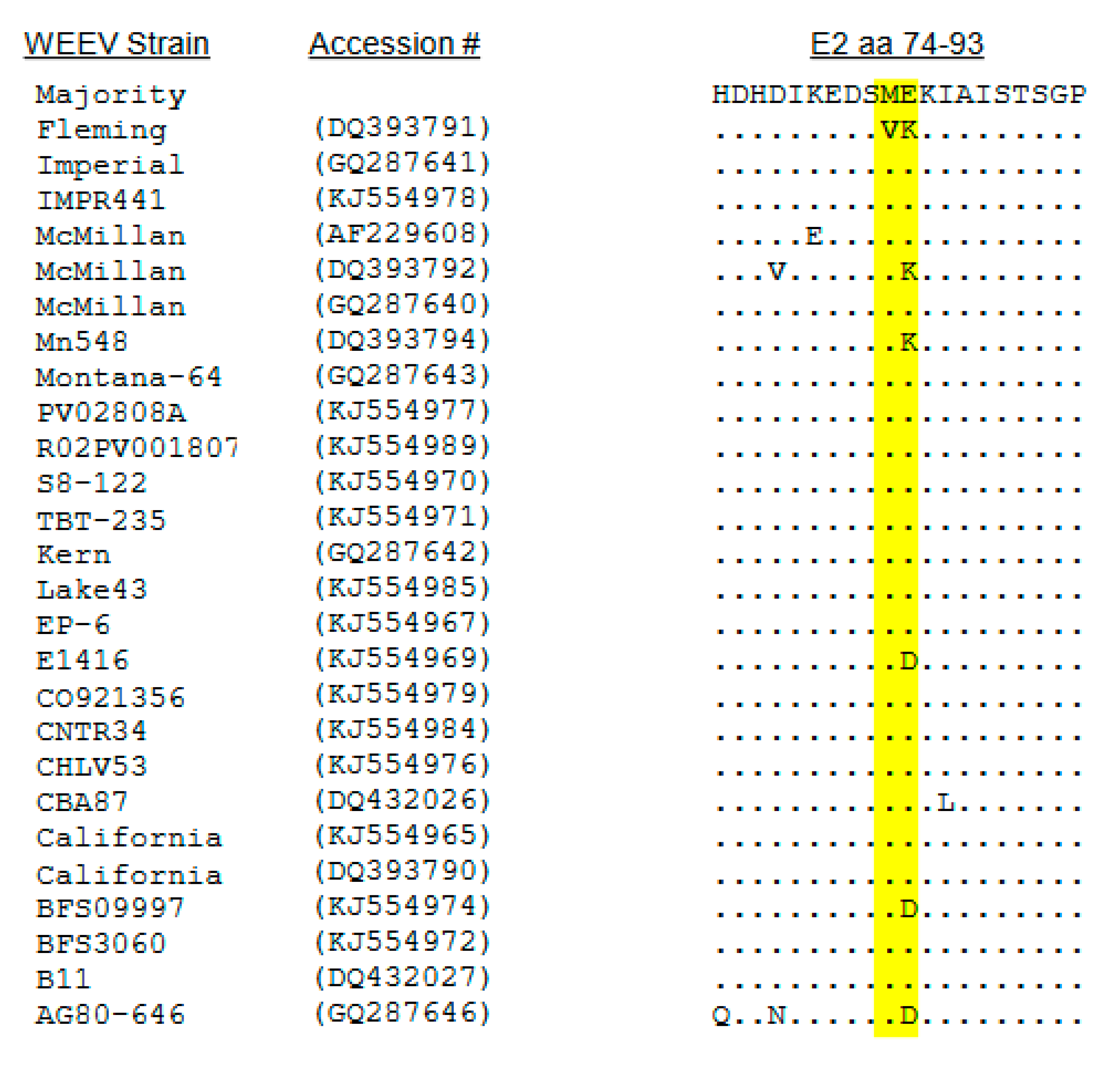

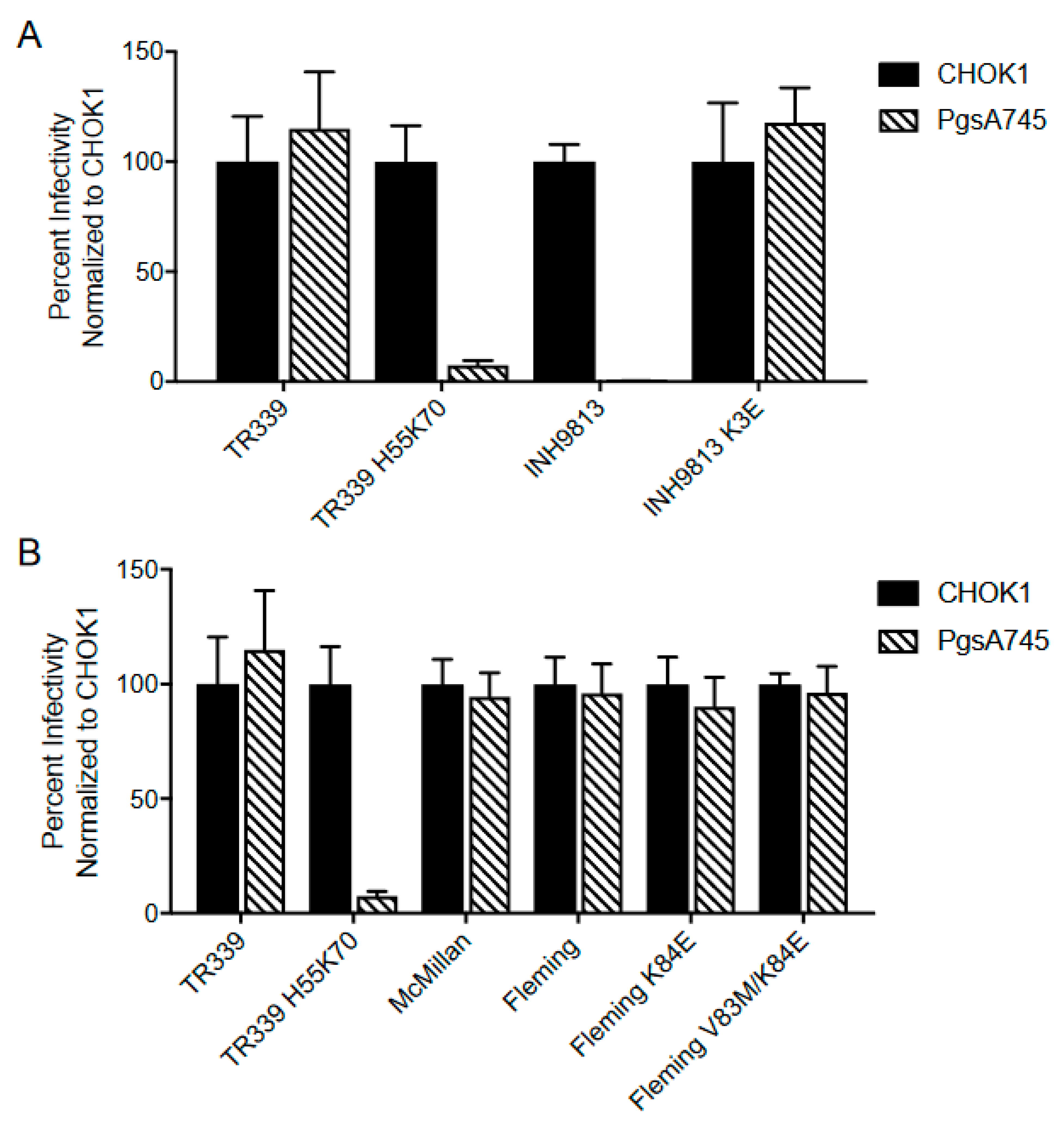
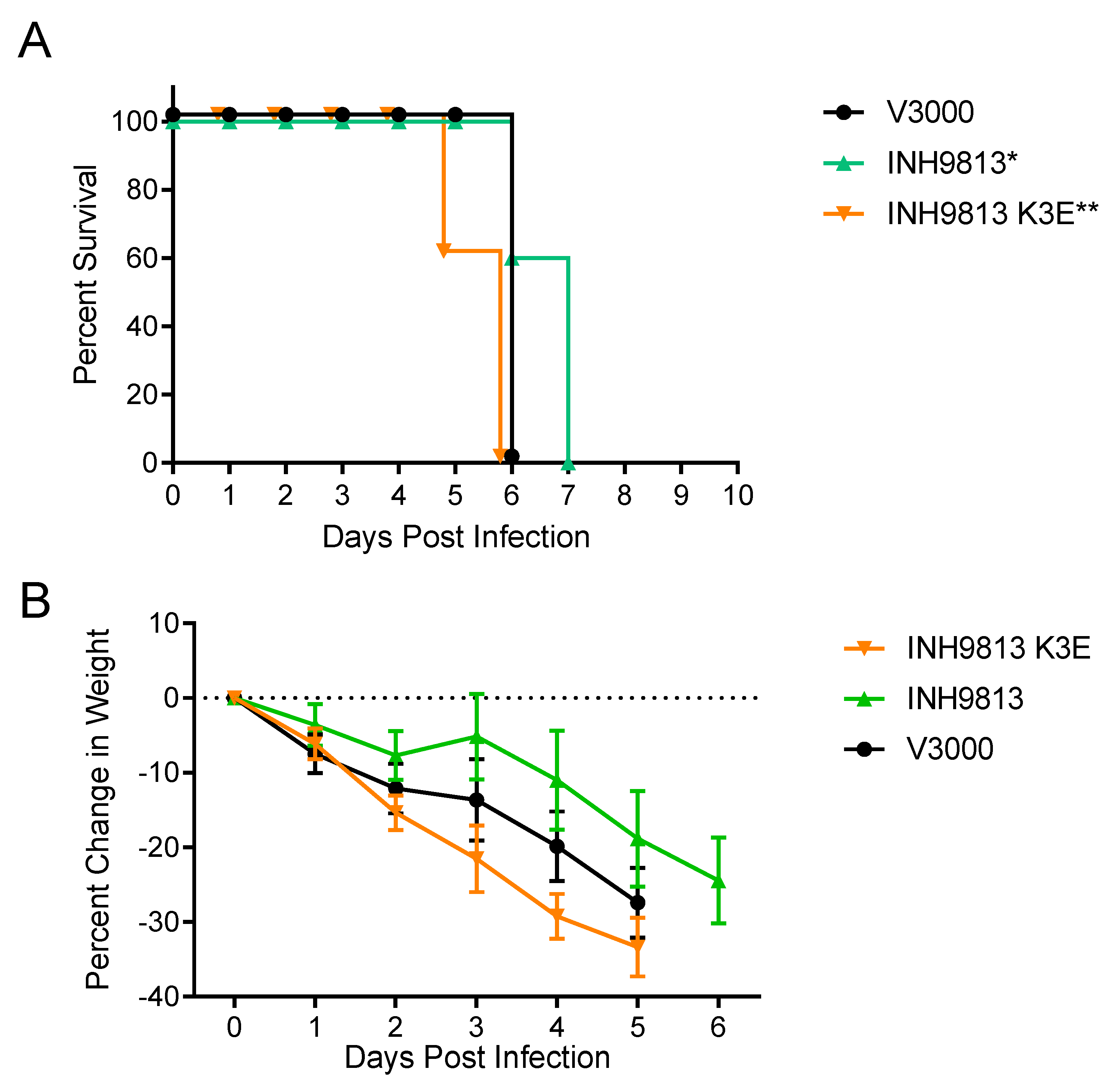
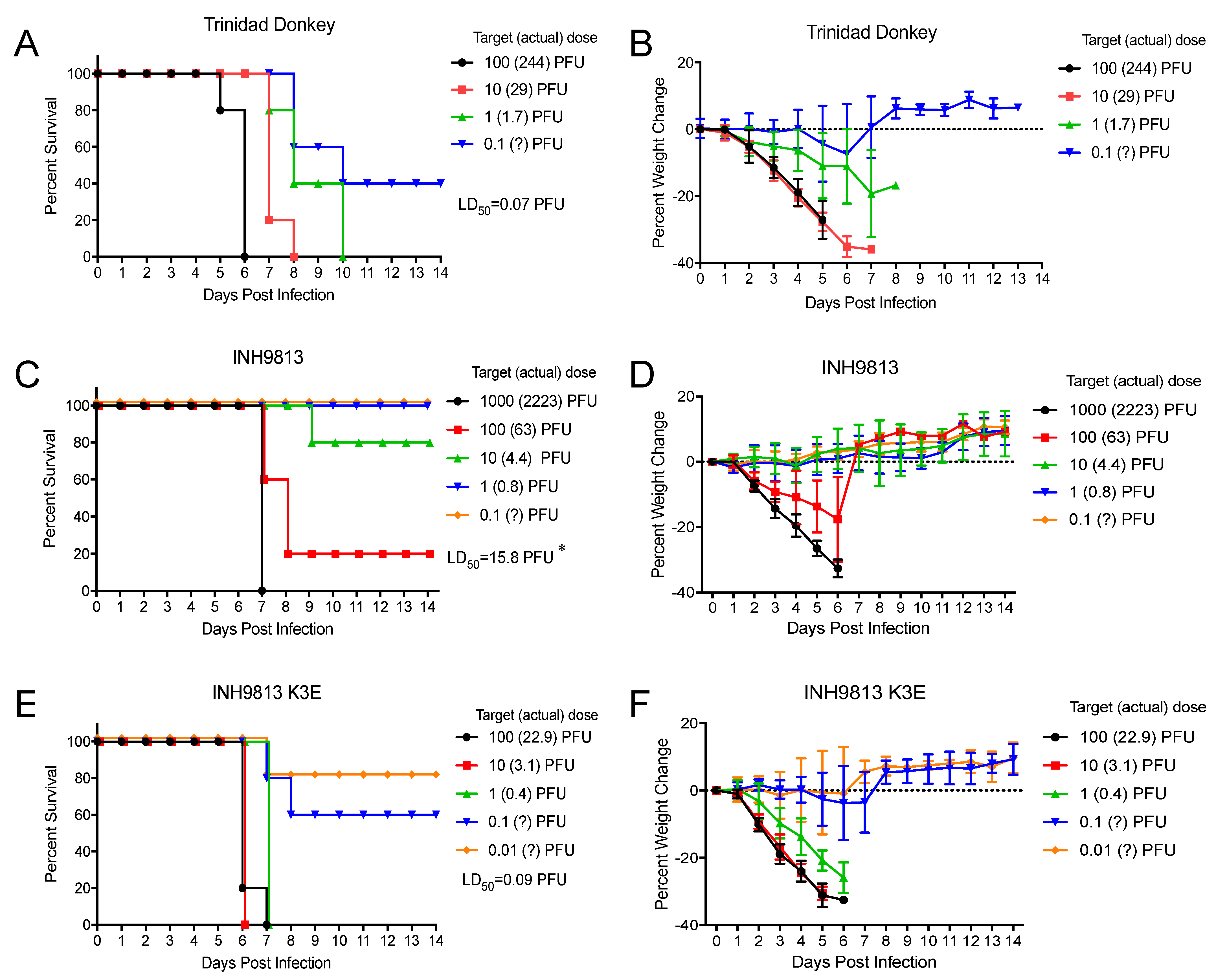
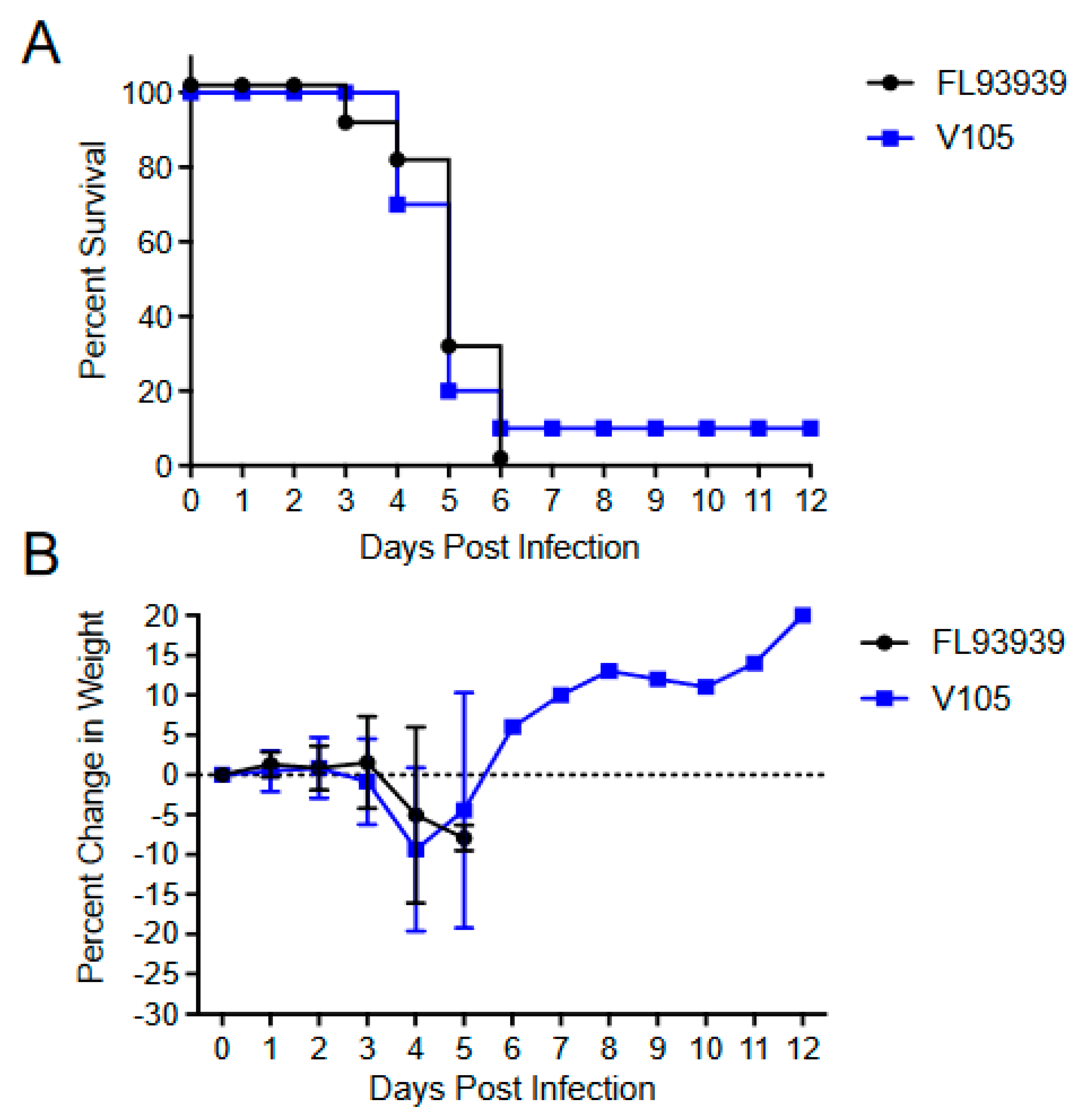
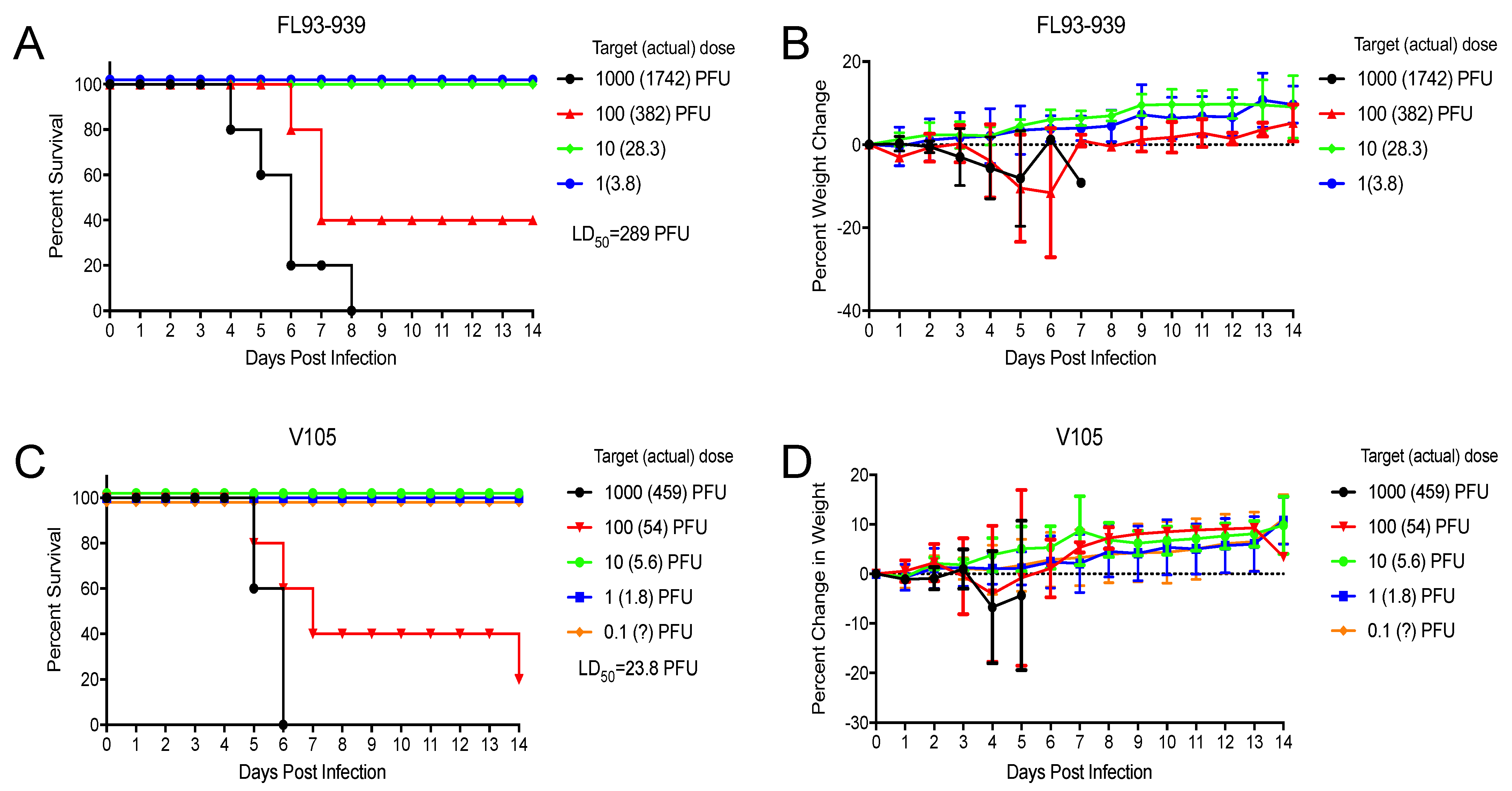
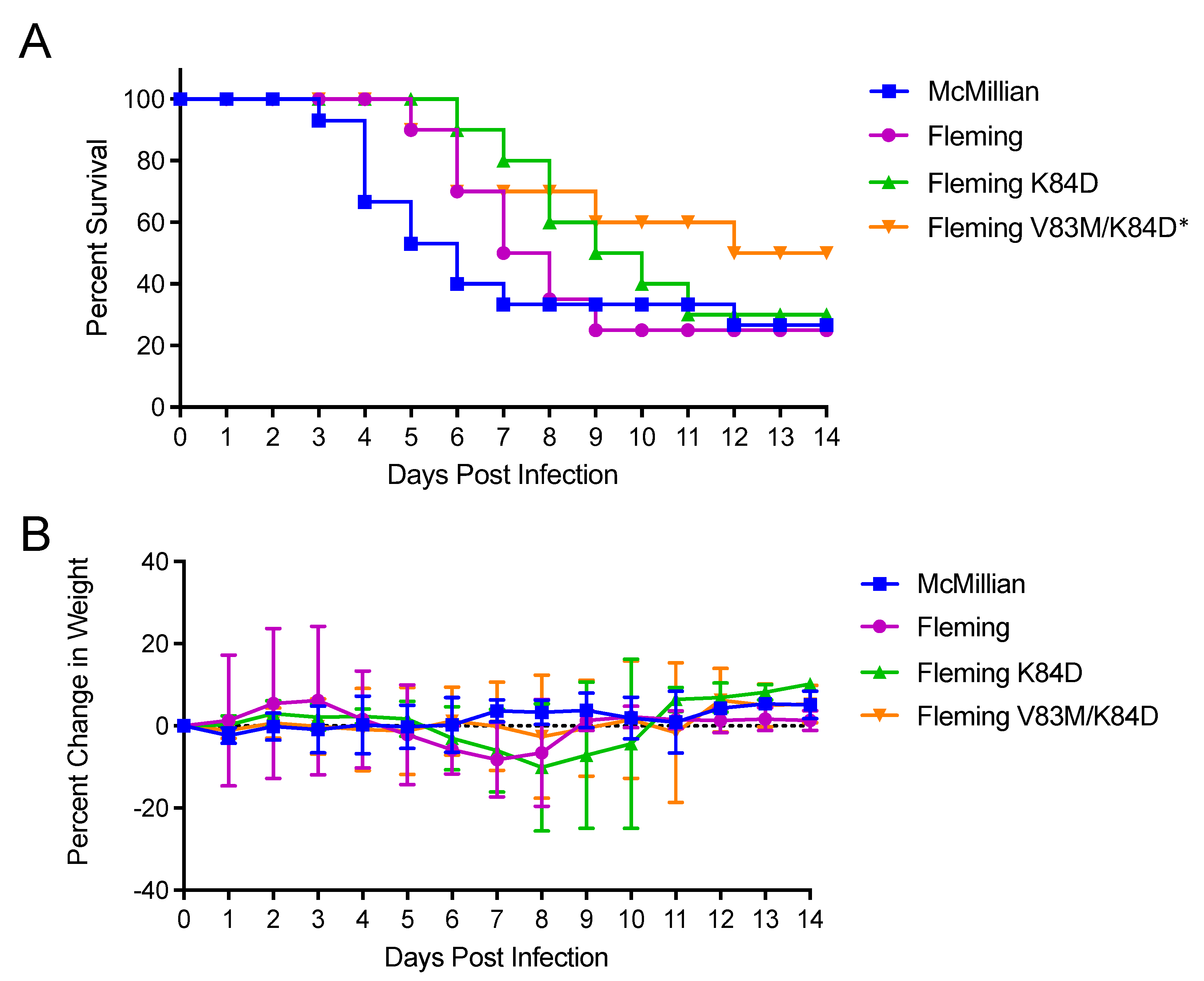
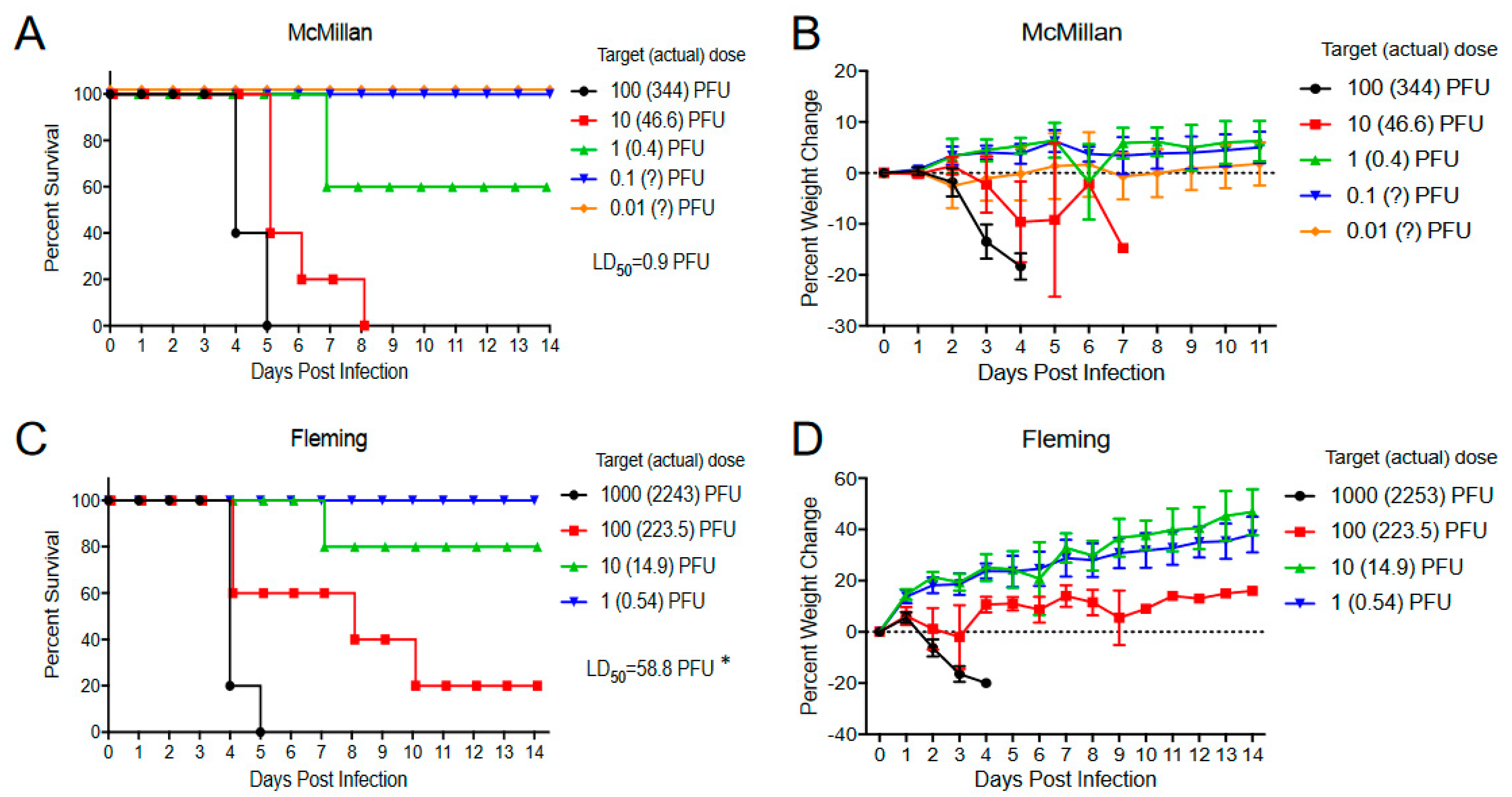
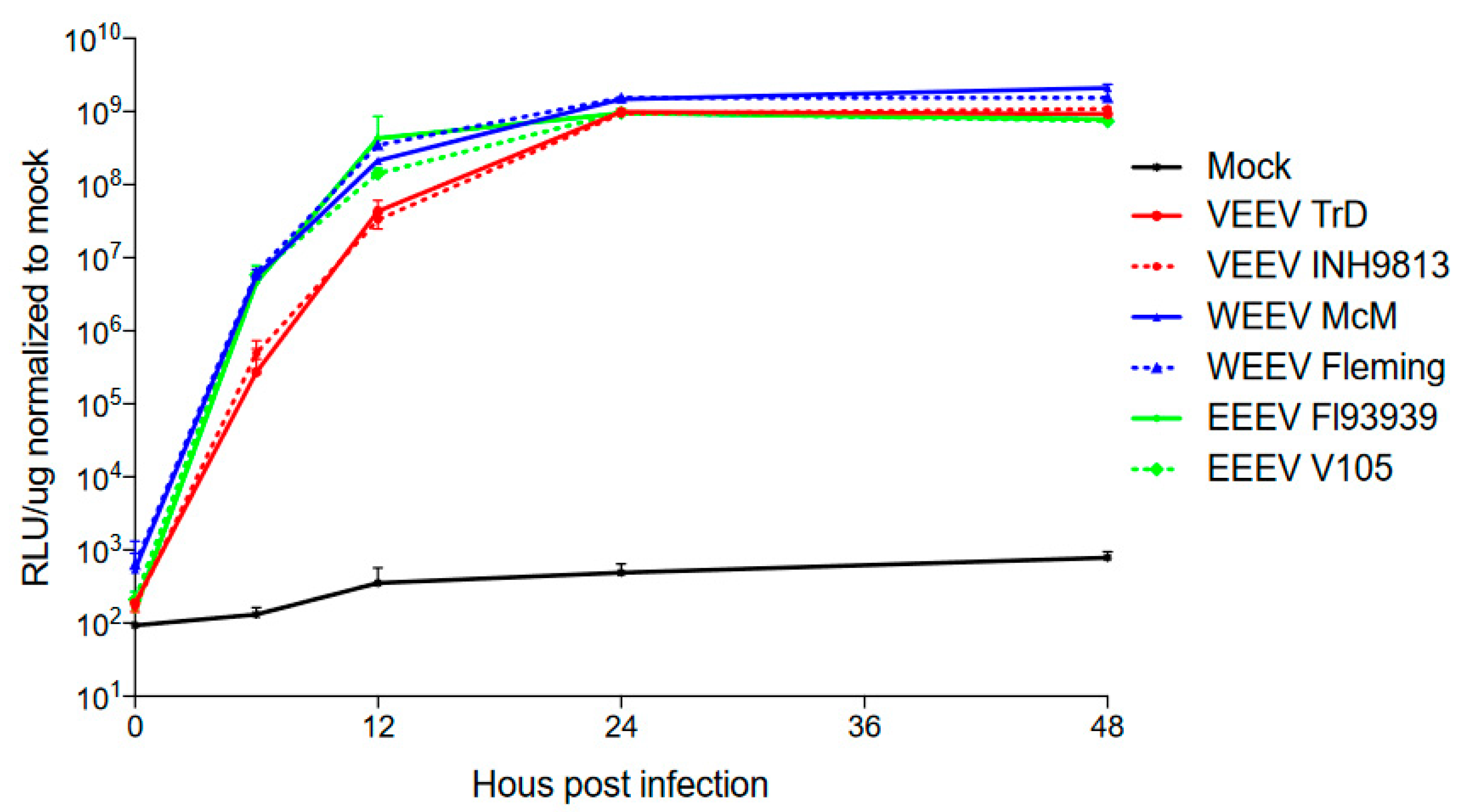
| Virus/Clone | Subtype | Passage 1 | Reference |
|---|---|---|---|
| VEEV Trinidad Donkey/V3000 | IA/B epizootic | GP-1, CE-14, SMB-1, V-2, and BHK-1 | (P. Glass Pers. Comm.) |
| VEEV INH9813 | IC epizootic | V-3 | [26] |
| EEEV FL93-939 | North American | V-1, SMB-1 | [15] |
| EEEV V105 | North American | V-3 | [26] |
| WEEV McMillan | - | M-2, SMB-1, V-2 | [19] |
| WEEV Fleming | - | SMB-5, V-3 | (S. Weaver, Pers. Comm.) |
Disclaimer/Publisher’s Note: The statements, opinions and data contained in all publications are solely those of the individual author(s) and contributor(s) and not of MDPI and/or the editor(s). MDPI and/or the editor(s) disclaim responsibility for any injury to people or property resulting from any ideas, methods, instructions or products referred to in the content. |
© 2022 by the authors. Licensee MDPI, Basel, Switzerland. This article is an open access article distributed under the terms and conditions of the Creative Commons Attribution (CC BY) license (https://creativecommons.org/licenses/by/4.0/).
Share and Cite
Gardner, C.L.; Sun, C.; Dunn, M.D.; Gilliland, T.C., Jr.; Trobaugh, D.W.; Terada, Y.; Reed, D.S.; Hartman, A.L.; Klimstra, W.B. In Vitro and In Vivo Phenotypes of Venezuelan, Eastern and Western Equine Encephalitis Viruses Derived from cDNA Clones of Human Isolates. Viruses 2023, 15, 5. https://doi.org/10.3390/v15010005
Gardner CL, Sun C, Dunn MD, Gilliland TC Jr., Trobaugh DW, Terada Y, Reed DS, Hartman AL, Klimstra WB. In Vitro and In Vivo Phenotypes of Venezuelan, Eastern and Western Equine Encephalitis Viruses Derived from cDNA Clones of Human Isolates. Viruses. 2023; 15(1):5. https://doi.org/10.3390/v15010005
Chicago/Turabian StyleGardner, Christina L., Chengqun Sun, Matthew D. Dunn, Theron C. Gilliland, Jr., Derek W. Trobaugh, Yutaka Terada, Douglas S. Reed, Amy L. Hartman, and William B. Klimstra. 2023. "In Vitro and In Vivo Phenotypes of Venezuelan, Eastern and Western Equine Encephalitis Viruses Derived from cDNA Clones of Human Isolates" Viruses 15, no. 1: 5. https://doi.org/10.3390/v15010005
APA StyleGardner, C. L., Sun, C., Dunn, M. D., Gilliland, T. C., Jr., Trobaugh, D. W., Terada, Y., Reed, D. S., Hartman, A. L., & Klimstra, W. B. (2023). In Vitro and In Vivo Phenotypes of Venezuelan, Eastern and Western Equine Encephalitis Viruses Derived from cDNA Clones of Human Isolates. Viruses, 15(1), 5. https://doi.org/10.3390/v15010005






